Human Error in Industrial Settings: A Literature Review on Safety
VerifiedAdded on 2020/01/23
|7
|1764
|77
Literature Review
AI Summary
This literature review delves into the critical role of human error in industrial settings and its significant impact on environmental safety. It explores various perspectives on human error, from individual failures to systemic weaknesses, emphasizing the shift from manual control to supervisory roles due to automation. The review highlights factors that increase the likelihood of human error, such as inadequate procedures, task complexity, and adverse environmental conditions. It examines the importance of both visual and auditory signals in industrial control and the correlation between alarm urgency and danger levels. Furthermore, the review addresses the environmental consequences of industrial pollution, the need for government initiatives and legislation, and the importance of public participation in promoting ethical environmental behavior. It references numerous studies to support its findings and discusses strategies for reducing environmental harm through improved safety measures, cleaner production technologies, and enhanced punishment for corruption.
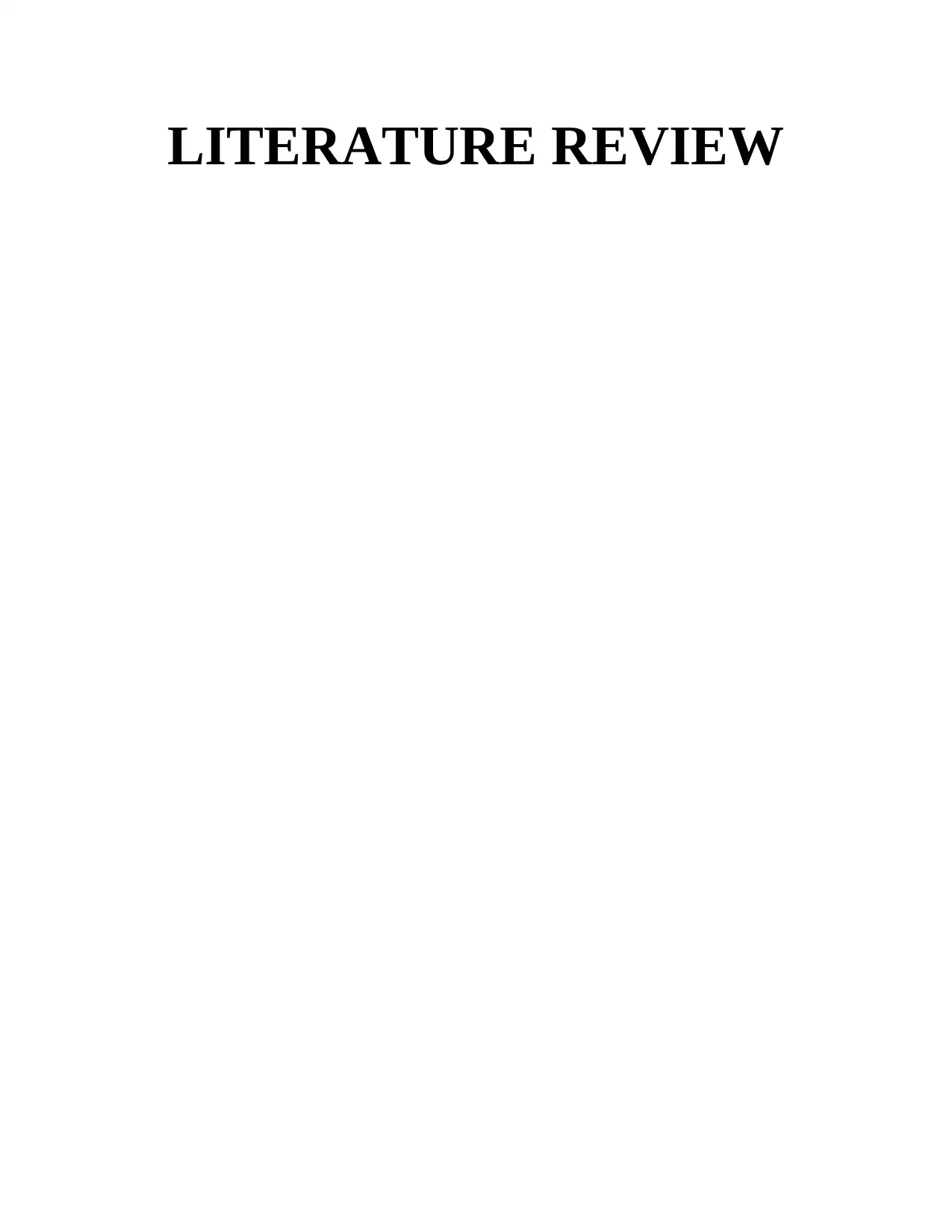
LITERATURE REVIEW
Paraphrase This Document
Need a fresh take? Get an instant paraphrase of this document with our AI Paraphraser
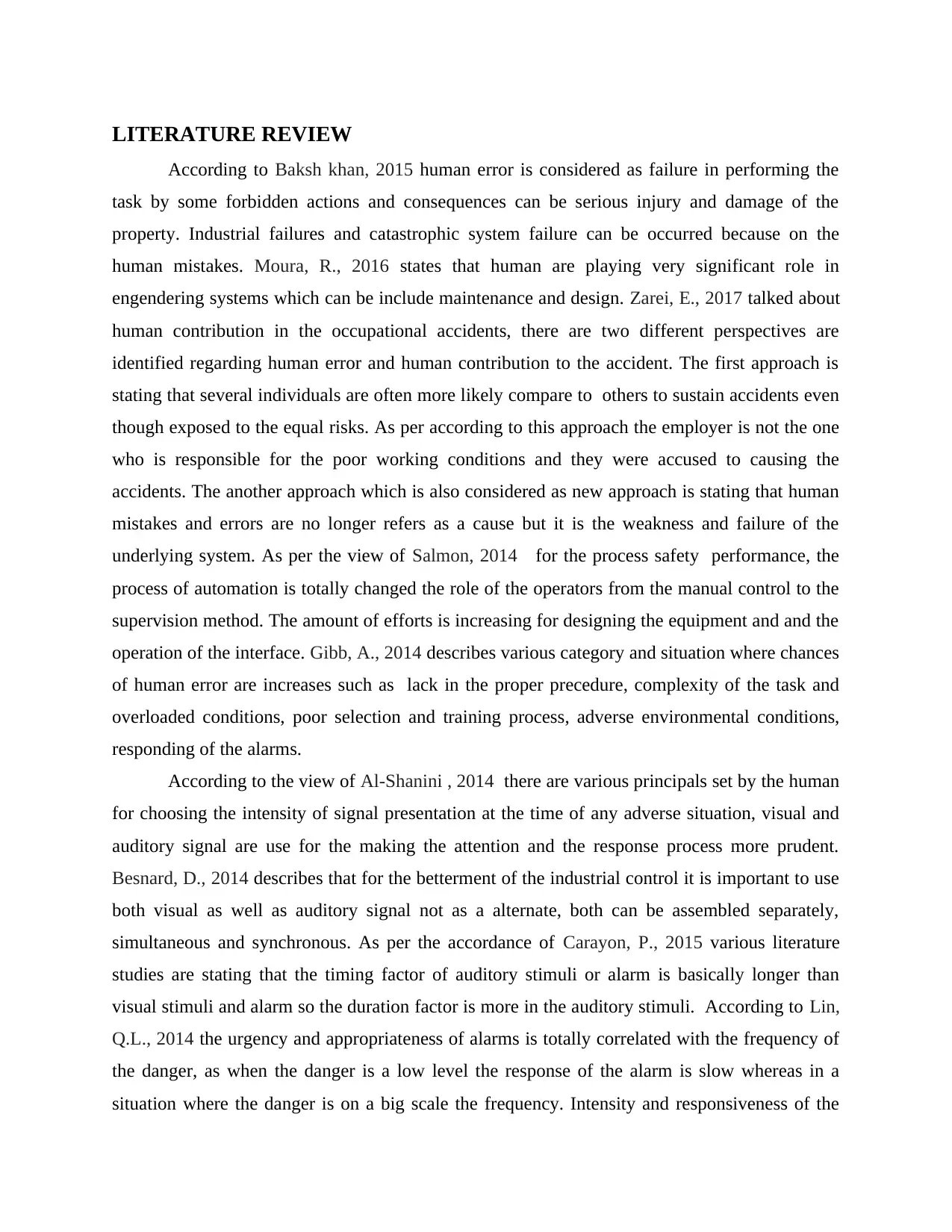
LITERATURE REVIEW
According to Baksh khan, 2015 human error is considered as failure in performing the
task by some forbidden actions and consequences can be serious injury and damage of the
property. Industrial failures and catastrophic system failure can be occurred because on the
human mistakes. Moura, R., 2016 states that human are playing very significant role in
engendering systems which can be include maintenance and design. Zarei, E., 2017 talked about
human contribution in the occupational accidents, there are two different perspectives are
identified regarding human error and human contribution to the accident. The first approach is
stating that several individuals are often more likely compare to others to sustain accidents even
though exposed to the equal risks. As per according to this approach the employer is not the one
who is responsible for the poor working conditions and they were accused to causing the
accidents. The another approach which is also considered as new approach is stating that human
mistakes and errors are no longer refers as a cause but it is the weakness and failure of the
underlying system. As per the view of Salmon, 2014 for the process safety performance, the
process of automation is totally changed the role of the operators from the manual control to the
supervision method. The amount of efforts is increasing for designing the equipment and and the
operation of the interface. Gibb, A., 2014 describes various category and situation where chances
of human error are increases such as lack in the proper precedure, complexity of the task and
overloaded conditions, poor selection and training process, adverse environmental conditions,
responding of the alarms.
According to the view of Al-Shanini , 2014 there are various principals set by the human
for choosing the intensity of signal presentation at the time of any adverse situation, visual and
auditory signal are use for the making the attention and the response process more prudent.
Besnard, D., 2014 describes that for the betterment of the industrial control it is important to use
both visual as well as auditory signal not as a alternate, both can be assembled separately,
simultaneous and synchronous. As per the accordance of Carayon, P., 2015 various literature
studies are stating that the timing factor of auditory stimuli or alarm is basically longer than
visual stimuli and alarm so the duration factor is more in the auditory stimuli. According to Lin,
Q.L., 2014 the urgency and appropriateness of alarms is totally correlated with the frequency of
the danger, as when the danger is a low level the response of the alarm is slow whereas in a
situation where the danger is on a big scale the frequency. Intensity and responsiveness of the
According to Baksh khan, 2015 human error is considered as failure in performing the
task by some forbidden actions and consequences can be serious injury and damage of the
property. Industrial failures and catastrophic system failure can be occurred because on the
human mistakes. Moura, R., 2016 states that human are playing very significant role in
engendering systems which can be include maintenance and design. Zarei, E., 2017 talked about
human contribution in the occupational accidents, there are two different perspectives are
identified regarding human error and human contribution to the accident. The first approach is
stating that several individuals are often more likely compare to others to sustain accidents even
though exposed to the equal risks. As per according to this approach the employer is not the one
who is responsible for the poor working conditions and they were accused to causing the
accidents. The another approach which is also considered as new approach is stating that human
mistakes and errors are no longer refers as a cause but it is the weakness and failure of the
underlying system. As per the view of Salmon, 2014 for the process safety performance, the
process of automation is totally changed the role of the operators from the manual control to the
supervision method. The amount of efforts is increasing for designing the equipment and and the
operation of the interface. Gibb, A., 2014 describes various category and situation where chances
of human error are increases such as lack in the proper precedure, complexity of the task and
overloaded conditions, poor selection and training process, adverse environmental conditions,
responding of the alarms.
According to the view of Al-Shanini , 2014 there are various principals set by the human
for choosing the intensity of signal presentation at the time of any adverse situation, visual and
auditory signal are use for the making the attention and the response process more prudent.
Besnard, D., 2014 describes that for the betterment of the industrial control it is important to use
both visual as well as auditory signal not as a alternate, both can be assembled separately,
simultaneous and synchronous. As per the accordance of Carayon, P., 2015 various literature
studies are stating that the timing factor of auditory stimuli or alarm is basically longer than
visual stimuli and alarm so the duration factor is more in the auditory stimuli. According to Lin,
Q.L., 2014 the urgency and appropriateness of alarms is totally correlated with the frequency of
the danger, as when the danger is a low level the response of the alarm is slow whereas in a
situation where the danger is on a big scale the frequency. Intensity and responsiveness of the
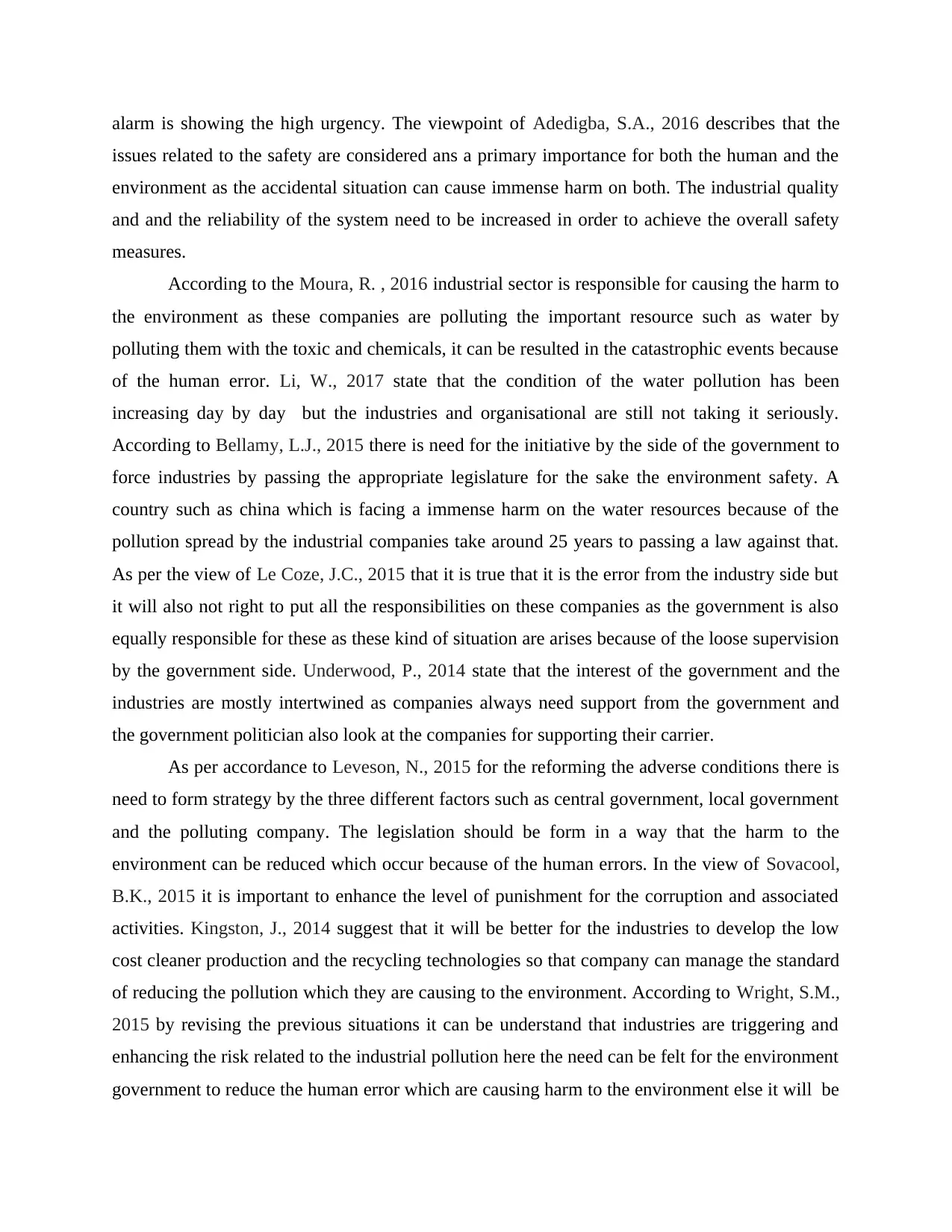
alarm is showing the high urgency. The viewpoint of Adedigba, S.A., 2016 describes that the
issues related to the safety are considered ans a primary importance for both the human and the
environment as the accidental situation can cause immense harm on both. The industrial quality
and and the reliability of the system need to be increased in order to achieve the overall safety
measures.
According to the Moura, R. , 2016 industrial sector is responsible for causing the harm to
the environment as these companies are polluting the important resource such as water by
polluting them with the toxic and chemicals, it can be resulted in the catastrophic events because
of the human error. Li, W., 2017 state that the condition of the water pollution has been
increasing day by day but the industries and organisational are still not taking it seriously.
According to Bellamy, L.J., 2015 there is need for the initiative by the side of the government to
force industries by passing the appropriate legislature for the sake the environment safety. A
country such as china which is facing a immense harm on the water resources because of the
pollution spread by the industrial companies take around 25 years to passing a law against that.
As per the view of Le Coze, J.C., 2015 that it is true that it is the error from the industry side but
it will also not right to put all the responsibilities on these companies as the government is also
equally responsible for these as these kind of situation are arises because of the loose supervision
by the government side. Underwood, P., 2014 state that the interest of the government and the
industries are mostly intertwined as companies always need support from the government and
the government politician also look at the companies for supporting their carrier.
As per accordance to Leveson, N., 2015 for the reforming the adverse conditions there is
need to form strategy by the three different factors such as central government, local government
and the polluting company. The legislation should be form in a way that the harm to the
environment can be reduced which occur because of the human errors. In the view of Sovacool,
B.K., 2015 it is important to enhance the level of punishment for the corruption and associated
activities. Kingston, J., 2014 suggest that it will be better for the industries to develop the low
cost cleaner production and the recycling technologies so that company can manage the standard
of reducing the pollution which they are causing to the environment. According to Wright, S.M.,
2015 by revising the previous situations it can be understand that industries are triggering and
enhancing the risk related to the industrial pollution here the need can be felt for the environment
government to reduce the human error which are causing harm to the environment else it will be
issues related to the safety are considered ans a primary importance for both the human and the
environment as the accidental situation can cause immense harm on both. The industrial quality
and and the reliability of the system need to be increased in order to achieve the overall safety
measures.
According to the Moura, R. , 2016 industrial sector is responsible for causing the harm to
the environment as these companies are polluting the important resource such as water by
polluting them with the toxic and chemicals, it can be resulted in the catastrophic events because
of the human error. Li, W., 2017 state that the condition of the water pollution has been
increasing day by day but the industries and organisational are still not taking it seriously.
According to Bellamy, L.J., 2015 there is need for the initiative by the side of the government to
force industries by passing the appropriate legislature for the sake the environment safety. A
country such as china which is facing a immense harm on the water resources because of the
pollution spread by the industrial companies take around 25 years to passing a law against that.
As per the view of Le Coze, J.C., 2015 that it is true that it is the error from the industry side but
it will also not right to put all the responsibilities on these companies as the government is also
equally responsible for these as these kind of situation are arises because of the loose supervision
by the government side. Underwood, P., 2014 state that the interest of the government and the
industries are mostly intertwined as companies always need support from the government and
the government politician also look at the companies for supporting their carrier.
As per accordance to Leveson, N., 2015 for the reforming the adverse conditions there is
need to form strategy by the three different factors such as central government, local government
and the polluting company. The legislation should be form in a way that the harm to the
environment can be reduced which occur because of the human errors. In the view of Sovacool,
B.K., 2015 it is important to enhance the level of punishment for the corruption and associated
activities. Kingston, J., 2014 suggest that it will be better for the industries to develop the low
cost cleaner production and the recycling technologies so that company can manage the standard
of reducing the pollution which they are causing to the environment. According to Wright, S.M.,
2015 by revising the previous situations it can be understand that industries are triggering and
enhancing the risk related to the industrial pollution here the need can be felt for the environment
government to reduce the human error which are causing harm to the environment else it will be
You're viewing a preview
Unlock full access by subscribing today!
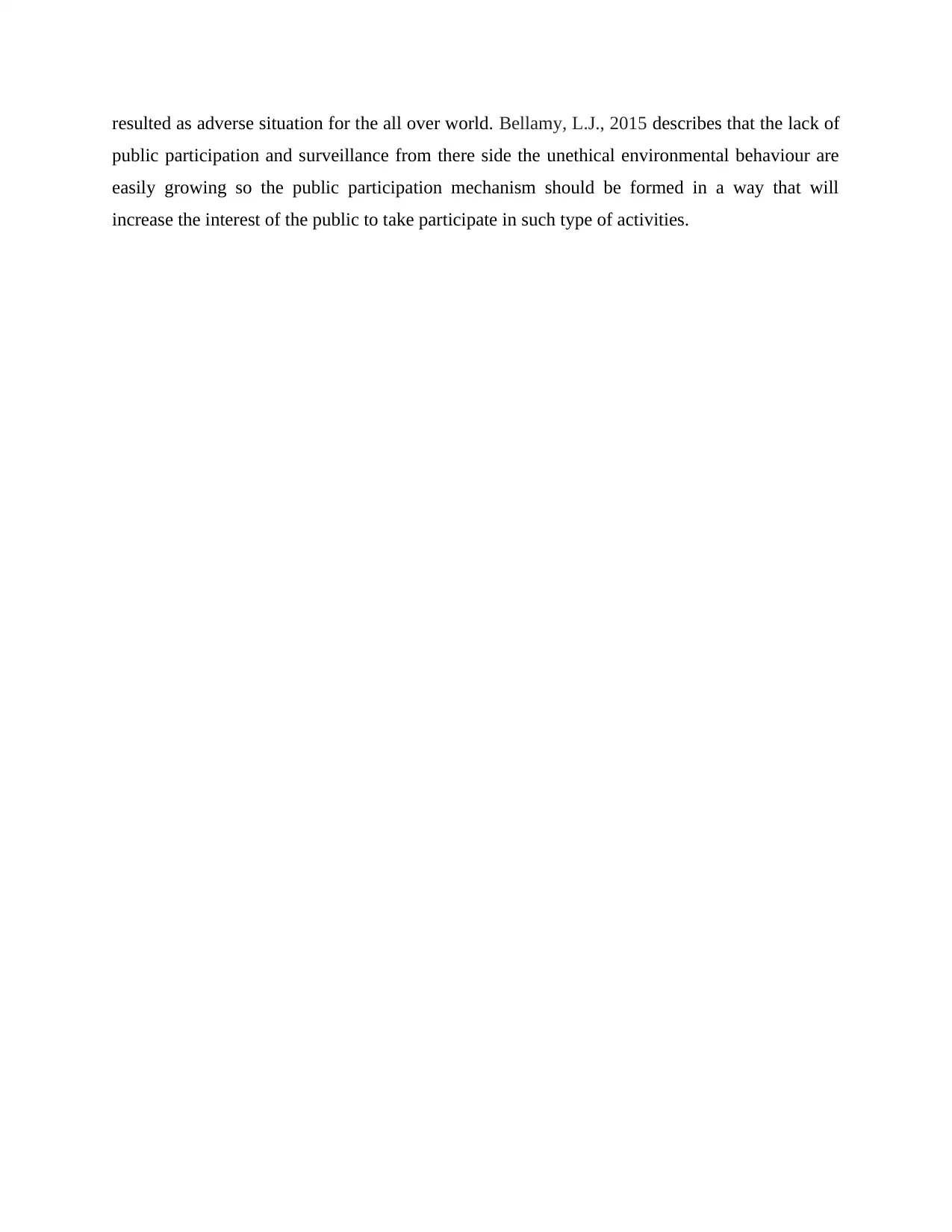
resulted as adverse situation for the all over world. Bellamy, L.J., 2015 describes that the lack of
public participation and surveillance from there side the unethical environmental behaviour are
easily growing so the public participation mechanism should be formed in a way that will
increase the interest of the public to take participate in such type of activities.
public participation and surveillance from there side the unethical environmental behaviour are
easily growing so the public participation mechanism should be formed in a way that will
increase the interest of the public to take participate in such type of activities.
Paraphrase This Document
Need a fresh take? Get an instant paraphrase of this document with our AI Paraphraser
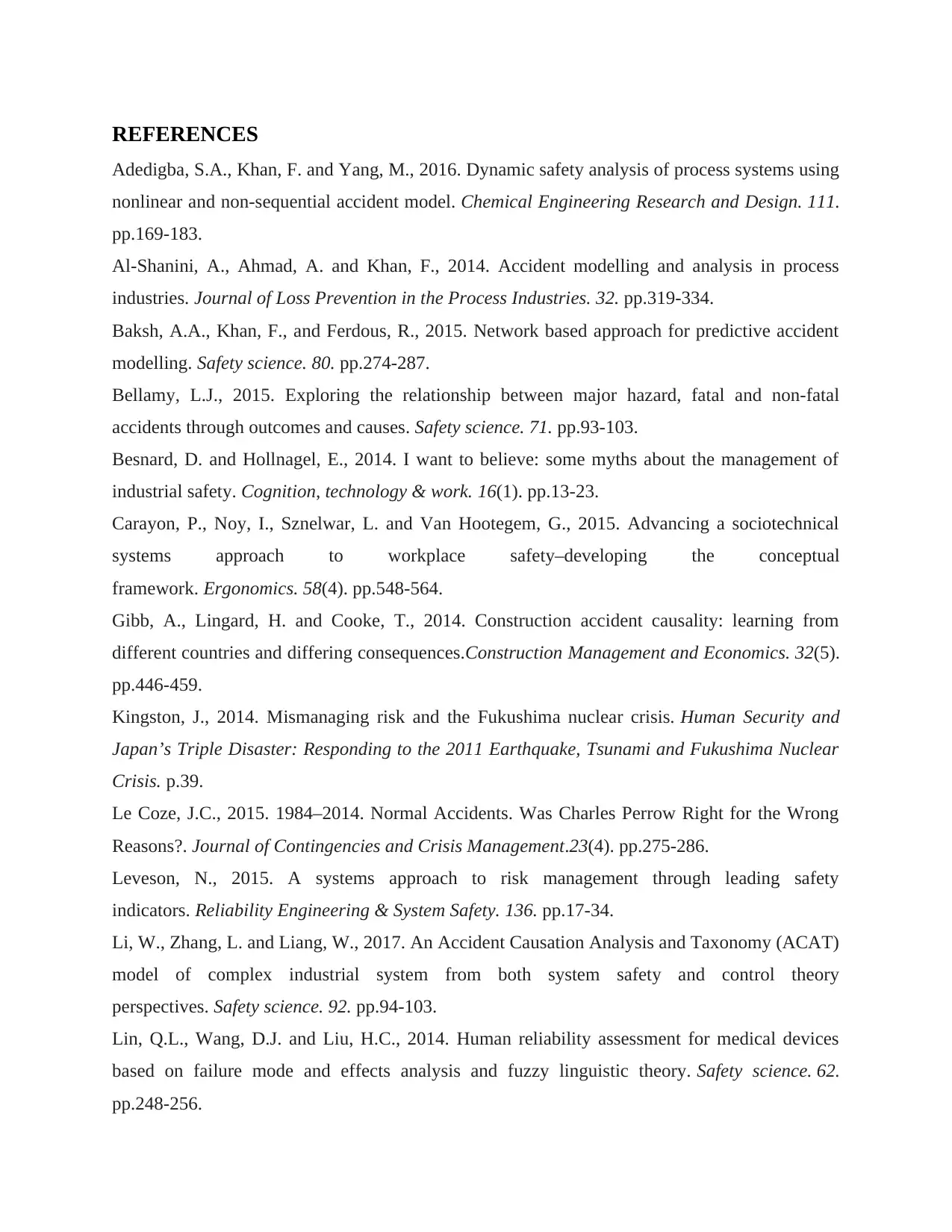
REFERENCES
Adedigba, S.A., Khan, F. and Yang, M., 2016. Dynamic safety analysis of process systems using
nonlinear and non-sequential accident model. Chemical Engineering Research and Design. 111.
pp.169-183.
Al-Shanini, A., Ahmad, A. and Khan, F., 2014. Accident modelling and analysis in process
industries. Journal of Loss Prevention in the Process Industries. 32. pp.319-334.
Baksh, A.A., Khan, F., and Ferdous, R., 2015. Network based approach for predictive accident
modelling. Safety science. 80. pp.274-287.
Bellamy, L.J., 2015. Exploring the relationship between major hazard, fatal and non-fatal
accidents through outcomes and causes. Safety science. 71. pp.93-103.
Besnard, D. and Hollnagel, E., 2014. I want to believe: some myths about the management of
industrial safety. Cognition, technology & work. 16(1). pp.13-23.
Carayon, P., Noy, I., Sznelwar, L. and Van Hootegem, G., 2015. Advancing a sociotechnical
systems approach to workplace safety–developing the conceptual
framework. Ergonomics. 58(4). pp.548-564.
Gibb, A., Lingard, H. and Cooke, T., 2014. Construction accident causality: learning from
different countries and differing consequences.Construction Management and Economics. 32(5).
pp.446-459.
Kingston, J., 2014. Mismanaging risk and the Fukushima nuclear crisis. Human Security and
Japan’s Triple Disaster: Responding to the 2011 Earthquake, Tsunami and Fukushima Nuclear
Crisis. p.39.
Le Coze, J.C., 2015. 1984–2014. Normal Accidents. Was Charles Perrow Right for the Wrong
Reasons?. Journal of Contingencies and Crisis Management.23(4). pp.275-286.
Leveson, N., 2015. A systems approach to risk management through leading safety
indicators. Reliability Engineering & System Safety. 136. pp.17-34.
Li, W., Zhang, L. and Liang, W., 2017. An Accident Causation Analysis and Taxonomy (ACAT)
model of complex industrial system from both system safety and control theory
perspectives. Safety science. 92. pp.94-103.
Lin, Q.L., Wang, D.J. and Liu, H.C., 2014. Human reliability assessment for medical devices
based on failure mode and effects analysis and fuzzy linguistic theory. Safety science. 62.
pp.248-256.
Adedigba, S.A., Khan, F. and Yang, M., 2016. Dynamic safety analysis of process systems using
nonlinear and non-sequential accident model. Chemical Engineering Research and Design. 111.
pp.169-183.
Al-Shanini, A., Ahmad, A. and Khan, F., 2014. Accident modelling and analysis in process
industries. Journal of Loss Prevention in the Process Industries. 32. pp.319-334.
Baksh, A.A., Khan, F., and Ferdous, R., 2015. Network based approach for predictive accident
modelling. Safety science. 80. pp.274-287.
Bellamy, L.J., 2015. Exploring the relationship between major hazard, fatal and non-fatal
accidents through outcomes and causes. Safety science. 71. pp.93-103.
Besnard, D. and Hollnagel, E., 2014. I want to believe: some myths about the management of
industrial safety. Cognition, technology & work. 16(1). pp.13-23.
Carayon, P., Noy, I., Sznelwar, L. and Van Hootegem, G., 2015. Advancing a sociotechnical
systems approach to workplace safety–developing the conceptual
framework. Ergonomics. 58(4). pp.548-564.
Gibb, A., Lingard, H. and Cooke, T., 2014. Construction accident causality: learning from
different countries and differing consequences.Construction Management and Economics. 32(5).
pp.446-459.
Kingston, J., 2014. Mismanaging risk and the Fukushima nuclear crisis. Human Security and
Japan’s Triple Disaster: Responding to the 2011 Earthquake, Tsunami and Fukushima Nuclear
Crisis. p.39.
Le Coze, J.C., 2015. 1984–2014. Normal Accidents. Was Charles Perrow Right for the Wrong
Reasons?. Journal of Contingencies and Crisis Management.23(4). pp.275-286.
Leveson, N., 2015. A systems approach to risk management through leading safety
indicators. Reliability Engineering & System Safety. 136. pp.17-34.
Li, W., Zhang, L. and Liang, W., 2017. An Accident Causation Analysis and Taxonomy (ACAT)
model of complex industrial system from both system safety and control theory
perspectives. Safety science. 92. pp.94-103.
Lin, Q.L., Wang, D.J. and Liu, H.C., 2014. Human reliability assessment for medical devices
based on failure mode and effects analysis and fuzzy linguistic theory. Safety science. 62.
pp.248-256.
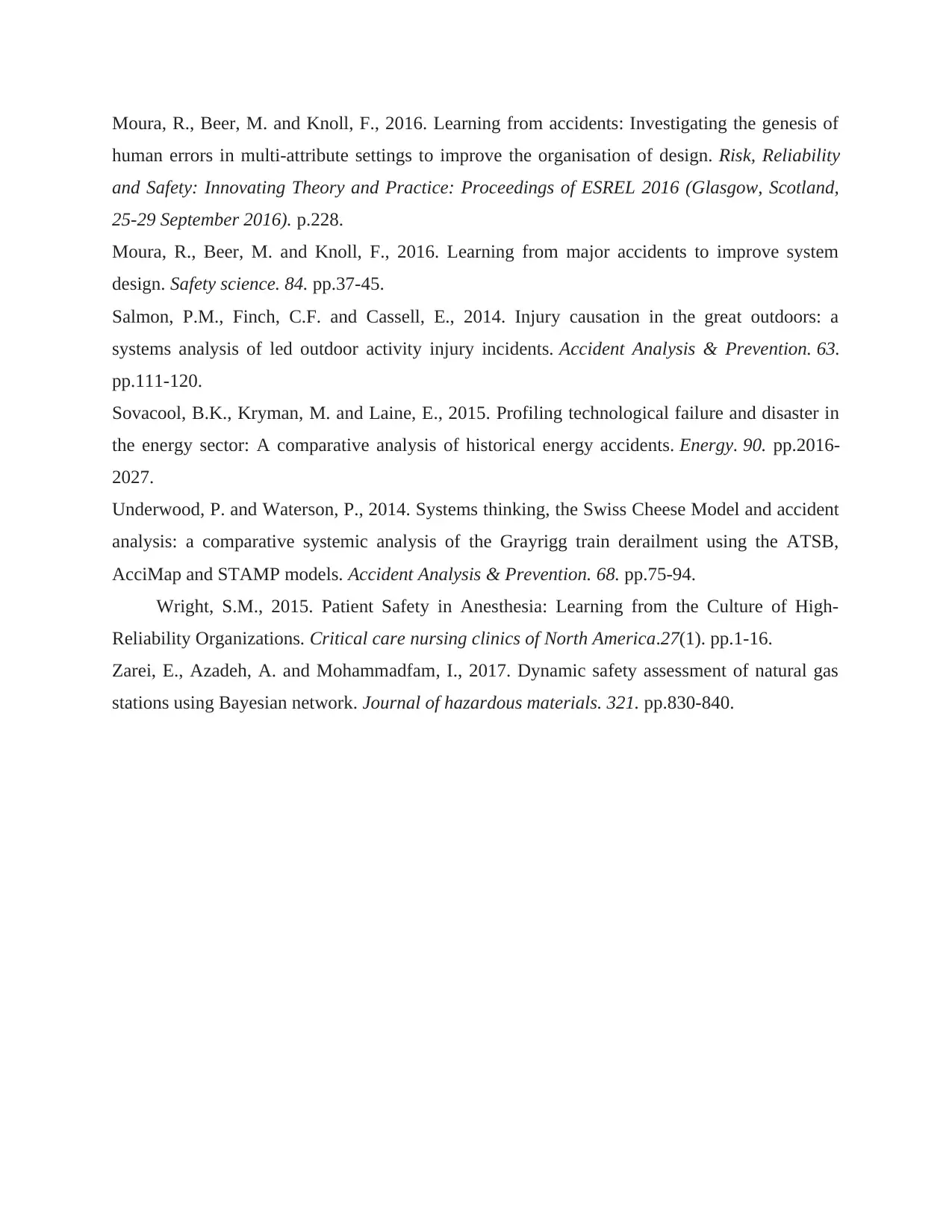
Moura, R., Beer, M. and Knoll, F., 2016. Learning from accidents: Investigating the genesis of
human errors in multi-attribute settings to improve the organisation of design. Risk, Reliability
and Safety: Innovating Theory and Practice: Proceedings of ESREL 2016 (Glasgow, Scotland,
25-29 September 2016). p.228.
Moura, R., Beer, M. and Knoll, F., 2016. Learning from major accidents to improve system
design. Safety science. 84. pp.37-45.
Salmon, P.M., Finch, C.F. and Cassell, E., 2014. Injury causation in the great outdoors: a
systems analysis of led outdoor activity injury incidents. Accident Analysis & Prevention. 63.
pp.111-120.
Sovacool, B.K., Kryman, M. and Laine, E., 2015. Profiling technological failure and disaster in
the energy sector: A comparative analysis of historical energy accidents. Energy. 90. pp.2016-
2027.
Underwood, P. and Waterson, P., 2014. Systems thinking, the Swiss Cheese Model and accident
analysis: a comparative systemic analysis of the Grayrigg train derailment using the ATSB,
AcciMap and STAMP models. Accident Analysis & Prevention. 68. pp.75-94.
Wright, S.M., 2015. Patient Safety in Anesthesia: Learning from the Culture of High-
Reliability Organizations. Critical care nursing clinics of North America.27(1). pp.1-16.
Zarei, E., Azadeh, A. and Mohammadfam, I., 2017. Dynamic safety assessment of natural gas
stations using Bayesian network. Journal of hazardous materials. 321. pp.830-840.
human errors in multi-attribute settings to improve the organisation of design. Risk, Reliability
and Safety: Innovating Theory and Practice: Proceedings of ESREL 2016 (Glasgow, Scotland,
25-29 September 2016). p.228.
Moura, R., Beer, M. and Knoll, F., 2016. Learning from major accidents to improve system
design. Safety science. 84. pp.37-45.
Salmon, P.M., Finch, C.F. and Cassell, E., 2014. Injury causation in the great outdoors: a
systems analysis of led outdoor activity injury incidents. Accident Analysis & Prevention. 63.
pp.111-120.
Sovacool, B.K., Kryman, M. and Laine, E., 2015. Profiling technological failure and disaster in
the energy sector: A comparative analysis of historical energy accidents. Energy. 90. pp.2016-
2027.
Underwood, P. and Waterson, P., 2014. Systems thinking, the Swiss Cheese Model and accident
analysis: a comparative systemic analysis of the Grayrigg train derailment using the ATSB,
AcciMap and STAMP models. Accident Analysis & Prevention. 68. pp.75-94.
Wright, S.M., 2015. Patient Safety in Anesthesia: Learning from the Culture of High-
Reliability Organizations. Critical care nursing clinics of North America.27(1). pp.1-16.
Zarei, E., Azadeh, A. and Mohammadfam, I., 2017. Dynamic safety assessment of natural gas
stations using Bayesian network. Journal of hazardous materials. 321. pp.830-840.
You're viewing a preview
Unlock full access by subscribing today!

1 out of 7
Your All-in-One AI-Powered Toolkit for Academic Success.
+13062052269
info@desklib.com
Available 24*7 on WhatsApp / Email
![[object Object]](/_next/static/media/star-bottom.7253800d.svg)
Unlock your academic potential
© 2024 | Zucol Services PVT LTD | All rights reserved.


